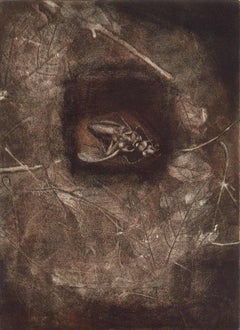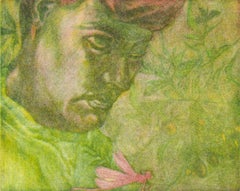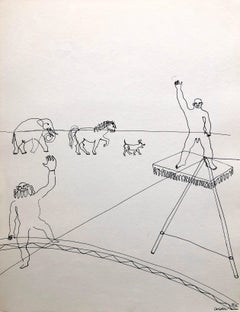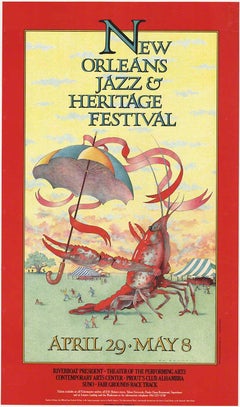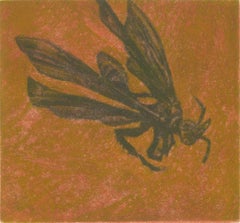Lois Ward Prints and Multiples
to
1
2
Overall Width
to
Overall Height
to
2
2
1,171
920
894
818
2
2
1
1
1
1
1
1
1
2
2
2
Artist: Lois Ward
Crushed Beetle / Fragile Series
By Lois Ward
Located in New Orleans, LA
Lois Ward created a Fragile Series of images including "Crushed Beetle" in 1990 in a very small edition of just 9. This impression is #1 of 9.
Ward has always been concerned with t...
Category
1990s American Modern Lois Ward Prints and Multiples
Materials
Mezzotint
$105 Sale Price
30% Off
Red Damsel (Human looks at small Tinker Bell like figure)
By Lois Ward
Located in New Orleans, LA
Lois Ward's "Red Damsel" is a color mezzotint created in 1994 in a very small edition of just 10. This impression is #2 of 10. A young human figure in green gazes down on a Tinker B...
Category
1990s American Modern Lois Ward Prints and Multiples
Materials
Mezzotint
Related Items
Alexander Calder Circus Reproduction Lithograph After a Drawing
By (after) Alexander Calder
Located in Surfside, FL
(after) Alexander Calder
"Calder's Circus" offset lithograph on wove paper after drawings by the artist
Published by Art in America and Perls gallery in 1964 (from drawings done in the 1930's)
these range slightly in size but they are all about 13 X 17 inches (with minor variations in size as issued.) These have never been framed. The outer folio is not included just the one lithograph.
James Sweeny from the introduction “The fame of Calder’s circus spread quickly between the years 1927 and 1930. All the Paris art world came to know it. It brought him his first great personal success. But what was more important, the circus also provided the first steps in Calder’s development as an original sculptor”
Clive Gray wrote ”A visit to the studio of Alexander Calder led to the chance discovery of some hundred masterful circus drawings completed over thirty years ago. We publish, for the first time, a choice of sixteen from that group.” With signed introduction by Miro.
These whimsical drawings, done in the style of wire sculpture, include acrobats, clowns, jugglers, trapeeze artists, an elephant, dog and lion. they are great.
Alexander Calder is widely considered to be one of the most important American sculptors of the 20th century. He is best known for his colorful, whimsical abstract public sculptures and his innovative mobiles, kinetic sculptures powered by motors or air currents, which embraced chance in their aesthetic. Born into a family of accomplished artists, Calder's work first gained attention in Paris in the 1930s and was soon championed by the Museum of Modern Art in New York, resulting in a retrospective exhibition in 1943. Major retrospectives were also held at the Solomon R. Guggenheim Museum (1964) and the Museum of Contemporary Art, Chicago (1974). Calder’s work is in many permanent collections, most notably in the Whitney Museum of American Art, but also the Guggenheim Museum; the Museum of Modern Art; the National Gallery of Art, Washington, D.C.; and the Centre Georges Pompidou. He produced many large public works, including .125 (at JFK Airport, 1957), Pittsburgh (Carnegie International prize winner 1958, Pittsburgh International Airport) Spirale (UNESCO in Paris, 1958), Flamingo and Universe (both in Chicago, 1974), and Mountains and Clouds (Hart Senate Office Building, Washington, D.C., 1976). Although primarily known for his sculpture, Calder was a prodigious artist with a restless creative spirit, whose diverse practice included painting and printmaking, miniatures (such as his famous Cirque Calder), children’s book illustrations, theater set design, jewelry design, tapestry and rug works, and political posters. Calder was honored by the US Postal Service with a set of five 32-cent stamps in 1998, and received the Presidential Medal of Freedom, posthumously in 1977, after refusing to receive it from Gerald Ford one year earlier in protest of the Vietnam War.
Calder moved to New York and enrolled at the Art Students League, studying briefly with Thomas Hart Benton, George Luks, Kenneth Hayes Miller, and John Sloan. While a student, he worked for the National Police Gazette where, in 1925, one of his assignments was sketching the Ringling Bros. and Barnum & Bailey Circus. Calder became fascinated with the action of the circus, a theme that would reappear in his later work.
In 1926, Calder moved to Paris, enrolled in the Académie de la Grande Chaumière, and established a studio at 22 rue Daguerre in the Montparnasse Quarter. In June 1929, while traveling by boat from Paris to New York, Calder met his future wife, Louisa James (1905-1996), grandniece of author Henry James and philosopher William James. They married in 1931. While in Paris, Calder met and became friends with a number of avant-garde artists, including Fernand Léger, Jean Arp, and Marcel Duchamp. Cirque Calder (on view at the Whitney Museum of American Art at present) became popular with the Parisian avant-garde. He also invented wire sculpture, or "drawing in space," and in 1929 he had his first solo show of these sculptures in Paris at Galerie Billiet. Hi! (Two Acrobats) in the collection of the Honolulu Museum of Art is an early example of the artist's wire sculpture. The painter Jules Pascin, a friend of Calder's from the cafes of Montparnasse, wrote the preface to the catalog. A visit to Piet Mondrian's studio in 1930, where he was impressed by the environment-as-installation, "shocked" him into fully embracing abstract art, toward which he had already been tending.
Dating from 1931, Calder’s sculptures of discrete movable parts powered by motors were christened “mobiles” by Marcel Duchamp, a French pun meaning both "motion" and "motive." At the same time, Calder was also experimenting with self-supporting, static, abstract sculptures, dubbed "stabiles" by Jean Arp in 1932 to differentiate them from mobiles.
Public commissions increasingly came his way in the 1960s. Notable examples are .125 for JFK Airport in 1957, Spirale for UNESCO in Paris 1958 and Trois disques, commissioned for Expo 67 in Montreal, Quebec, Canada. Calder's largest sculpture at 25.7 meters high was El Sol Rojo, constructed outside the Aztec Stadium for the 1968 Summer Olympics "Cultural Olympiad" events in Mexico City. Many of his public works were commissioned by renowned architects; I.M. Pei commissioned his La Grande Voile (1966), a 25-ton, 40-foot high stabile for the Massachusetts Institute of Technology.
Part of Calder's repertoire includes pivotal stage sets for more than a dozen theatrical productions, including Nucléa, Horizon, and most notably, Martha Graham’s Panorama (1935), a production of the Erik Satie symphonic drama Socrate (1936), and later, Works in Progress (1968).
In addition to sculptures, Calder painted throughout his career, beginning in the early 1920s. He picked up his study of printmaking in 1925, and continued to produce illustrations for books and journals.As Calder’s professional reputation expanded in the late 1940s and 1950s, so did his production of prints. Masses of lithographs based on his gouache paintings hit the market, and deluxe editions of plays, poems, and short stories illustrated with fine art prints by Calder became available for sale.
One of Calder's most celebrated and unconventional undertakings was a commission from Dallas-based Braniff International Airways to paint a full-size Douglas DC-8-62 four-engined jet as a "flying canvas."
Calder created over 2,000 pieces of jewelry over the course of his career, many of them as gifts for friends and relatives. For his lifelong friend Joan Miró, he set a shard of a broken porcelain vessel in a brass ring. Peggy Guggenheim received enormous silver mobile earrings and later commissioned a hammered silver headboard...
Category
1930s American Modern Lois Ward Prints and Multiples
Materials
Lithograph
Original New Orleans Jazz & Heritage Festival vintage poster
Located in Spokane, WA
Original, Linen backed New Orleans Jazz & Heritage Festival poster from 1983. A fun image with a crawfish holding an umbrella with streamers. 1983 JAZZ & HERITAGE FESTIVAL PRO-MO ...
Category
1980s American Modern Lois Ward Prints and Multiples
Materials
Offset
$498
H 29.25 in W 17.25 in
Original "The Ships Are Coming" vintage American poster with an Eagle.
By James Henry Daugherty
Located in Spokane, WA
Original: THE SHIPS ARE COMING vintage poster. Artist: James H. Daugherty (1889-1974)
Publisher: U.S. Shipping Board, Emergency Fleet Corporation, Publication Section, Philadelphia, 1917.
Poster showing a giant eagle...
Category
1910s American Modern Lois Ward Prints and Multiples
Materials
Lithograph
James Henry DaughertyOriginal "The Ships Are Coming" vintage American poster with an Eagle., 1917-18
$1,663 Sale Price
20% Off
H 30 in W 20 in D 0.05 in
Reginald Wilson, Horses
By Reginald Wilson
Located in New York, NY
Although this work is titled Horses. It nice to think it could be (Horses in a Field in Woodstock, NY), but it was printed by Will Barnet at the Art Students League, about 1938, and Wilson, who visited Woodstock with Arnold Blanche...
Category
1930s American Modern Lois Ward Prints and Multiples
Materials
Lithograph
Haystack
By Thomas Hart Benton
Located in London, GB
A fine impression of this very popular image with full margins (smaller on top and bottom) published by Associated American Artists.
Category
1930s American Modern Lois Ward Prints and Multiples
Materials
Lithograph
Her Majesty's Stag Hounds on Ascot, A Colored 19th Century British Hunting Scene
Located in Alamo, CA
"The Meeting of Her Majesty's Stag Hounds on Ascot Heath" is a large colorful mezzotint engraving of an extensive British hunting scene. It was created by Sir Francis Grant...
Category
1830s Lois Ward Prints and Multiples
Materials
Engraving, Mezzotint
Francis Grant Her Majesty's Stag Hounds on Ascot, A Colored 19th Century British Hunting Scene, 1839
$1,340 Sale Price
20% Off
H 29 in W 38.88 in D 1.25 in
Dan Burne Jones, Affection
Located in New York, NY
Dan Burne Jones is widely know as the author of the Rockwell Kent print catalogue raisonne. It's so interesting to see that he is a gifted wood engraver as well. Jones's own prints a...
Category
1930s American Modern Lois Ward Prints and Multiples
Materials
Woodcut
Nebraska Evening
By Thomas Hart Benton
Located in London, GB
A fine impression with good margins published by Associated American Artists.
Category
1940s American Modern Lois Ward Prints and Multiples
Materials
Lithograph
Origiinal FRANCE, Paese dei Casstelli, vintage French travel poster on linen
By Jean Picart Le Doux
Located in Spokane, WA
Original 1950 “France, Paese dei Castelli” Vintage Poster Artist Jean Picart Le Doux Linen-Backed French Castles Travel Art Rare Mid-Century Collectible
Add a touch of French el...
Category
1950s American Modern Lois Ward Prints and Multiples
Materials
Lithograph
$975
H 39.5 in W 24.5 in D 0.3 in
Horse Laugh
By Alfred Bendiner
Located in New York, NY
Alfred Bendiner (1899-1964) was trained as an architect but worked as an artist throughout his career. He was a noted lithographer, as well an author, muralist, and caricaturist. The...
Category
Mid-20th Century American Modern Lois Ward Prints and Multiples
Materials
Crayon
Original 1919, Give the World The Once Over in the United States Navy poster
Located in Spokane, WA
Original 1919 Give The World The Once Over in the United States Navy vintage poster. Archival linen backed. This poster presents itself very fine condition. The lower text por...
Category
1910s American Modern Lois Ward Prints and Multiples
Materials
Lithograph
$2,998
H 42 in W 28.5 in D 0.05 in
Original Stan Galli "Pacific Northwest" United Air Lines Vintage Poster
By Stan Galli
Located in Spokane, WA
Original Stan Galli "Pacific Northwest" United Air Lines Vintage Poster – Stunning Mid-Century Travel Art. Archival linen backed in excellent condition, ready to frame. Grade A. ...
Category
1960s American Modern Lois Ward Prints and Multiples
Materials
Offset
$716 Sale Price
20% Off
H 40 in W 24.5 in D 0.05 in
Previously Available Items
Sleep Deeply My Lady
By Lois Ward
Located in New Orleans, LA
Lois Ward's "Sleep Deeply My Lady" is a color mezzotint created in 1994 in a very small edition of just 4. This impression is #1 of 4. A winged creature settl...
Category
1990s American Modern Lois Ward Prints and Multiples
Materials
Mezzotint
The Flames of Another Day
By Lois Ward
Located in New Orleans, LA
Lois Ward's "The Flames of Another Day" is a color mezzotint created in 1994 in a very small edition of just 2. This impression is #1 of 2. A winged creat...
Category
1990s American Modern Lois Ward Prints and Multiples
Materials
Mezzotint
The Storm
By Lois Ward
Located in New Orleans, LA
Lois Ward's "The Storm" is a color mezzotint created in 1994 in a very small edition of just 2. This impression is a trial proof. Heavy weather is disturbing the environment.
Ward h...
Category
1990s American Modern Lois Ward Prints and Multiples
Materials
Mezzotint
The Air Through Which We Fly
By Lois Ward
Located in New Orleans, LA
Lois Ward's "The Air Through Which We Fly" is a color mezzotint created in 1994 in a very small edition of just 2. This impression is an Artist's Proof. A winged creature flies in ...
Category
1990s American Modern Lois Ward Prints and Multiples
Materials
Mezzotint
Lois Ward prints and multiples for sale on 1stDibs.
Find a wide variety of authentic Lois Ward prints and multiples available for sale on 1stDibs. You can also browse by medium to find art by Lois Ward in engraving, mezzotint and more. Much of the original work by this artist or collective was created during the 1990s and is mostly associated with the modern style. Not every interior allows for large Lois Ward prints and multiples, so small editions measuring 6 inches across are available. Customers who are interested in this artist might also find the work of Donald Shaw MacLaughlan, Millard Sheets, and Frederick Mershimer. Lois Ward prints and multiples prices can differ depending upon medium, time period and other attributes. On 1stDibs, the price for these items starts at $100 and tops out at $105, while the average work can sell for $103.
